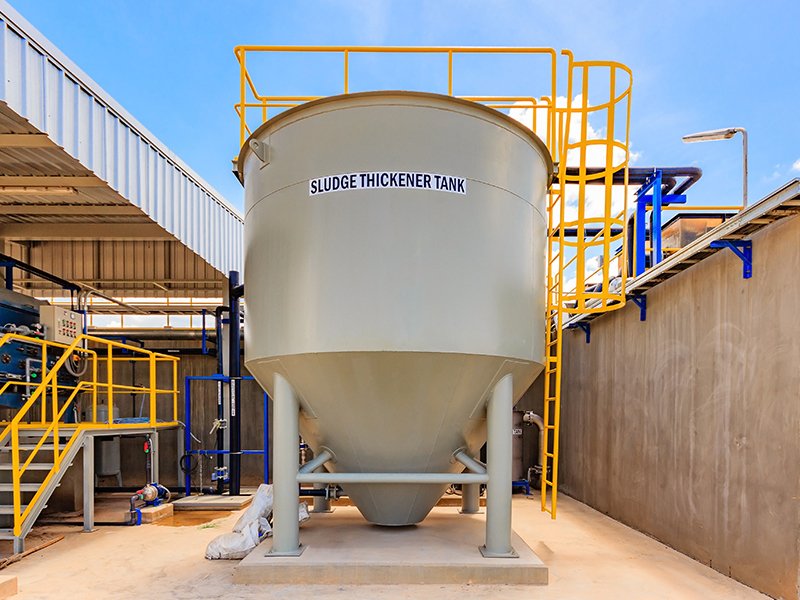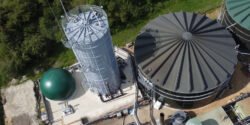Upflow Anaerobic Sludge Blanket Reactors

Upflow Anaerobic Sludge Blanket (UASB) Reactors: Harnessing Microbial Metabolism for Wastewater Treatment
I. Introduction
The quest for sustainable wastewater management has intensified over recent decades, driven by increasing environmental pollution and the need for resource recovery. Upflow Anaerobic Sludge Blanket (UASB) reactors have emerged as a prominent technology in this pursuit. This article delves deep into the principles, design, operational parameters, advantages, limitations, and real-world applications of UASB reactors.
II. Principles of UASB Reactors
-
- Anaerobic Digestion: At the heart of UASB technology lies anaerobic digestion, a process where microorganisms break down organic matter in the absence of oxygen. This results in biogas production, primarily methane, which can be harnessed as renewable energy.
- Anaerobic Digestion: At the heart of UASB technology lies anaerobic digestion, a process where microorganisms break down organic matter in the absence of oxygen. This results in biogas production, primarily methane, which can be harnessed as renewable energy.
-
- Granular Sludge Formation: UASB reactors uniquely promote the formation of dense sludge granules. These granules consist of microbial consortia that facilitate efficient wastewater treatment by allowing higher biomass retention and enhanced substrate utilization.
- Granular Sludge Formation: UASB reactors uniquely promote the formation of dense sludge granules. These granules consist of microbial consortia that facilitate efficient wastewater treatment by allowing higher biomass retention and enhanced substrate utilization.
-
- Upflow Regime: Wastewater is fed from the bottom, flowing upwards through the sludge blanket. This upflow motion ensures intimate contact between the wastewater and sludge granules, maximizing the degradation of organic pollutants.
III. Design Considerations
-
- Reactor Configuration: Typical UASB reactors are vertical, cylindrical tanks that can vary in size based on the treatment capacity. Essential features include an influent distribution system at the bottom, a sludge bed, gas-solid-liquid separators (GSLs), and an effluent withdrawal system at the top.
- Reactor Configuration: Typical UASB reactors are vertical, cylindrical tanks that can vary in size based on the treatment capacity. Essential features include an influent distribution system at the bottom, a sludge bed, gas-solid-liquid separators (GSLs), and an effluent withdrawal system at the top.
-
- Hydraulic Retention Time (HRT): HRT is a critical design parameter influencing the efficiency of the system. It typically ranges between 6-24 hours, depending on the nature of the wastewater and desired treatment efficiency.
- Hydraulic Retention Time (HRT): HRT is a critical design parameter influencing the efficiency of the system. It typically ranges between 6-24 hours, depending on the nature of the wastewater and desired treatment efficiency.
-
- Organic Loading Rate (OLR): This parameter, measured in kg COD/m³/day (Chemical Oxygen Demand per cubic meter per day), determines the amount of organic matter fed into the reactor. Optimal OLR ensures effective microbial activity while preventing process inhibition.
- Organic Loading Rate (OLR): This parameter, measured in kg COD/m³/day (Chemical Oxygen Demand per cubic meter per day), determines the amount of organic matter fed into the reactor. Optimal OLR ensures effective microbial activity while preventing process inhibition.
-
- Temperature Control: Anaerobic digestion is temperature-sensitive. Mesophilic (30-40°C) and thermophilic (50-60°C) conditions favor different microbial populations and digestion rates. Mesophilic conditions are more commonly employed due to their stability and energy efficiency.
- Temperature Control: Anaerobic digestion is temperature-sensitive. Mesophilic (30-40°C) and thermophilic (50-60°C) conditions favor different microbial populations and digestion rates. Mesophilic conditions are more commonly employed due to their stability and energy efficiency.
-
- Gas-Solid-Liquid Separators: GSLs are crucial for the effective separation of biogas, treated effluent, and sludge granules. Proper design and operation of GSLs prevent washout of biomass and ensure high-quality effluent.
IV. Operational Parameters
-
- pH and Alkalinity: The optimal pH range for UASB reactors is between 6.5 and 7.5. Alkalinity acts as a buffer to maintain pH stability, preventing acidic conditions that can inhibit microbial activity.
- pH and Alkalinity: The optimal pH range for UASB reactors is between 6.5 and 7.5. Alkalinity acts as a buffer to maintain pH stability, preventing acidic conditions that can inhibit microbial activity.
-
- Nutrient Balancing: Anaerobic microorganisms require a balanced supply of nutrients, including nitrogen, phosphorus, and trace elements. Insufficient nutrient supply can lead to suboptimal reactor performance.
- Nutrient Balancing: Anaerobic microorganisms require a balanced supply of nutrients, including nitrogen, phosphorus, and trace elements. Insufficient nutrient supply can lead to suboptimal reactor performance.
-
- Mixing and Hydraulic Shear: Adequate mixing ensures uniform distribution of substrate, nutrients, and microbial consortia. However, excessive hydraulic shear can disrupt sludge granulation.
- Mixing and Hydraulic Shear: Adequate mixing ensures uniform distribution of substrate, nutrients, and microbial consortia. However, excessive hydraulic shear can disrupt sludge granulation.
-
- Sludge Retention and Biomass Control: Effective sludge retention is critical for maintaining high biomass concentrations. Periodic sludge withdrawal helps control sludge age and prevents sludge washout.
V. Advantages of UASB Reactors
-
- Energy Efficiency: UASB reactors operate without the need for external aeration, significantly reducing energy consumption compared to aerobic systems.
- Energy Efficiency: UASB reactors operate without the need for external aeration, significantly reducing energy consumption compared to aerobic systems.
-
- Biogas Production: The production of methane-rich biogas offers a renewable energy source that can be harnessed for heating, electricity generation, or as a transportation fuel.
- Biogas Production: The production of methane-rich biogas offers a renewable energy source that can be harnessed for heating, electricity generation, or as a transportation fuel.
-
- Reduced Sludge Generation: The yield of sludge biomass in anaerobic digestion is lower compared to aerobic systems, reducing the burden of sludge handling and disposal.
- Reduced Sludge Generation: The yield of sludge biomass in anaerobic digestion is lower compared to aerobic systems, reducing the burden of sludge handling and disposal.
-
- Robustness: UASB reactors can handle a wide range of organic loadings and shock loads, providing operational flexibility.
- Robustness: UASB reactors can handle a wide range of organic loadings and shock loads, providing operational flexibility.
-
- Nutrient Retention: Anaerobic digestion allows for the retention of nutrients like nitrogen and phosphorus, which can be recovered and utilized as fertilizers.
VI. Limitations of UASB Reactors
-
- Start-up Phase: The initial start-up period for UASB reactors can be lengthy, often requiring several months to develop stable granular sludge.
- Start-up Phase: The initial start-up period for UASB reactors can be lengthy, often requiring several months to develop stable granular sludge.
-
- Sensitivity to Toxic Compounds: Anaerobic microorganisms can be sensitive to toxic compounds like heavy metals, sulfides, and certain industrial chemicals, impacting reactor performance.
- Sensitivity to Toxic Compounds: Anaerobic microorganisms can be sensitive to toxic compounds like heavy metals, sulfides, and certain industrial chemicals, impacting reactor performance.
-
- Temperature Sensitivity: Fluctuations in temperature can affect the microbial community and digestion rate, necessitating temperature control measures in colder climates.
- Temperature Sensitivity: Fluctuations in temperature can affect the microbial community and digestion rate, necessitating temperature control measures in colder climates.
-
- Effluent Quality: While UASB reactors efficiently reduce organic pollutants, they may require post-treatment steps to meet stringent discharge standards for nutrients and pathogens.
VII. Real-World Applications
-
- Municipal Wastewater Treatment: Many municipalities worldwide have adopted UASB technology for treating domestic wastewater. Notable examples include India, Brazil, and the Netherlands, where large-scale UASB plants have been operational for years.
- Municipal Wastewater Treatment: Many municipalities worldwide have adopted UASB technology for treating domestic wastewater. Notable examples include India, Brazil, and the Netherlands, where large-scale UASB plants have been operational for years.
-
- Industrial Wastewater Treatment: UASB reactors are widely used in industries like food and beverage, pulp and paper, and pharmaceuticals. These industries generate high-strength wastewater with significant organic loads, making them ideal candidates for anaerobic treatment.
- Industrial Wastewater Treatment: UASB reactors are widely used in industries like food and beverage, pulp and paper, and pharmaceuticals. These industries generate high-strength wastewater with significant organic loads, making them ideal candidates for anaerobic treatment.
-
- Agricultural Waste Management: Dairy farms, pig farms, and other agricultural operations produce wastewater rich in organic matter and nutrients. UASB reactors offer a sustainable solution for managing these waste streams and recovering valuable resources.
- Agricultural Waste Management: Dairy farms, pig farms, and other agricultural operations produce wastewater rich in organic matter and nutrients. UASB reactors offer a sustainable solution for managing these waste streams and recovering valuable resources.
-
- Resource Recovery in Developing Countries: UASB technology has gained traction in developing countries where conventional wastewater treatment infrastructure may be lacking. The low operational costs and energy efficiency align well with the resource constraints in these regions.
VIII. Case Studies
-
- The Surabaya UASB Plant, Indonesia: This plant treats municipal wastewater from the city of Surabaya. The UASB reactor, with a capacity of 10,000 m³/day, has demonstrated impressive performance, reducing COD by over 80% and generating substantial biogas.
- The Surabaya UASB Plant, Indonesia: This plant treats municipal wastewater from the city of Surabaya. The UASB reactor, with a capacity of 10,000 m³/day, has demonstrated impressive performance, reducing COD by over 80% and generating substantial biogas.
-
- Heineken Brewery, Netherlands: Heineken’s brewery in the Netherlands uses UASB reactors to treat its high-strength wastewater. The successful implementation has led to significant reductions in organic pollutants and notable biogas production, which is utilized within the facility.
- Heineken Brewery, Netherlands: Heineken’s brewery in the Netherlands uses UASB reactors to treat its high-strength wastewater. The successful implementation has led to significant reductions in organic pollutants and notable biogas production, which is utilized within the facility.
-
- Nestlé Dairy Plant, Brazil: Nestlé’s dairy processing plant in Brazil implemented a UASB system to manage its wastewater. The reactor handles an OLR of 5 kg COD/m³/day, achieving COD removal efficiencies exceeding 85%. The biogas produced is used for steam generation within the plant.
IX. Technological Innovations and Future Prospects
-
- Hybrid Systems: Combining UASB reactors with other treatment technologies, such as aerobic post-treatment or membrane filtration, enhances overall treatment efficiency and effluent quality.
- Hybrid Systems: Combining UASB reactors with other treatment technologies, such as aerobic post-treatment or membrane filtration, enhances overall treatment efficiency and effluent quality.
-
- Microbial Community Engineering: Advances in genomics and microbial ecology enable the engineering of microbial consortia tailored for specific waste streams. This approach can optimize reactor performance and resilience.
- Microbial Community Engineering: Advances in genomics and microbial ecology enable the engineering of microbial consortia tailored for specific waste streams. This approach can optimize reactor performance and resilience.
-
- Advanced Monitoring and Control Systems: The integration of real-time monitoring and automated control systems enhances operational reliability, allowing for adaptive management of UASB reactors.
- Advanced Monitoring and Control Systems: The integration of real-time monitoring and automated control systems enhances operational reliability, allowing for adaptive management of UASB reactors.
-
- Circular Economy and Resource Recovery: The focus on recovering valuable resources, such as nutrients and biopolymers, from wastewater will drive future developments in UASB technology, aligning with the principles of a circular economy.
X. Conclusion
Upflow Anaerobic Sludge Blanket reactors have established themselves as a cornerstone technology in sustainable wastewater management. Their ability to convert organic waste into valuable biogas while minimizing energy consumption and sludge production positions them as an attractive option for diverse applications. As technological advancements continue and global efforts toward environmental sustainability intensify, UASB reactors are poised to play a pivotal role in reshaping wastewater treatment paradigms for a more resilient future.



